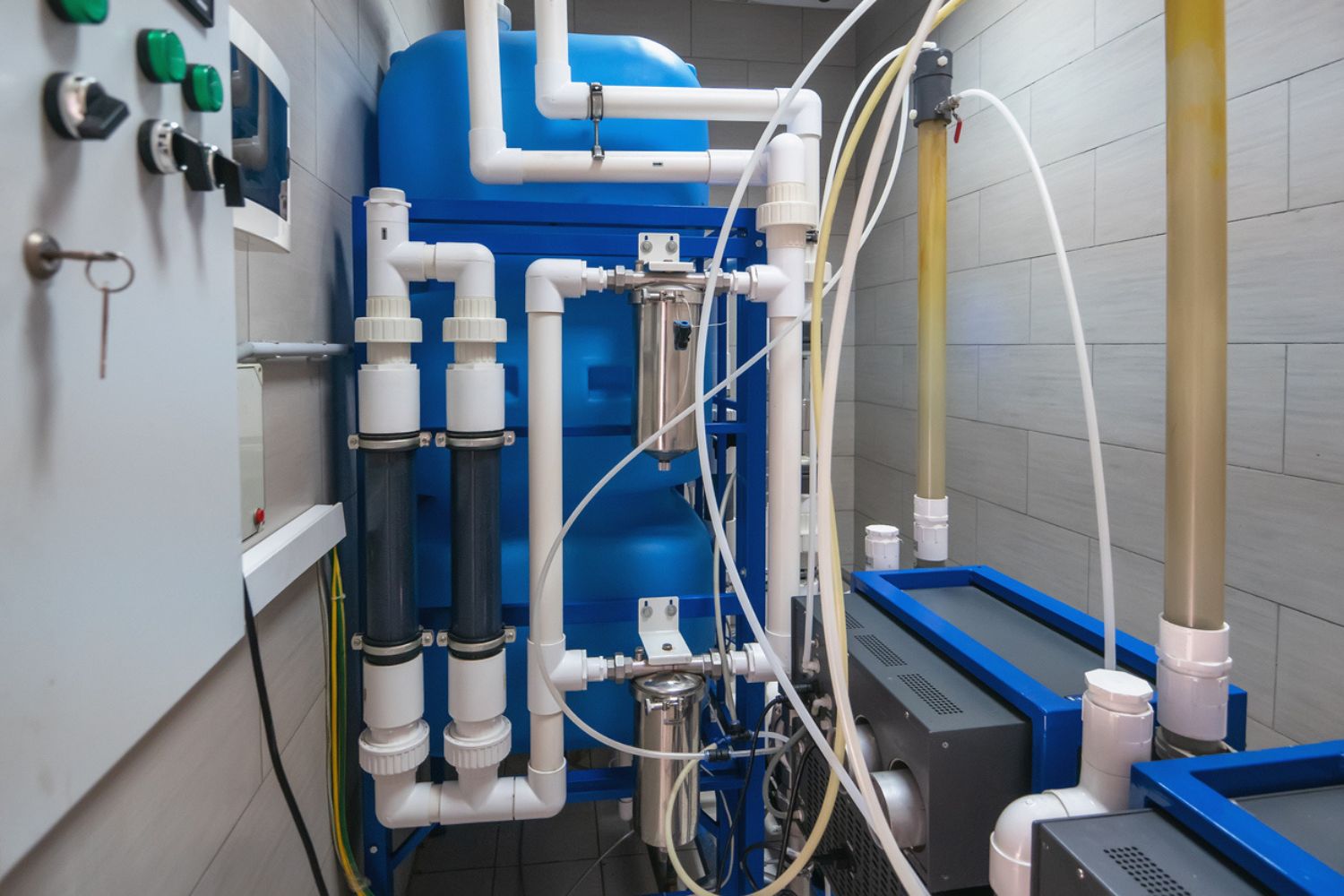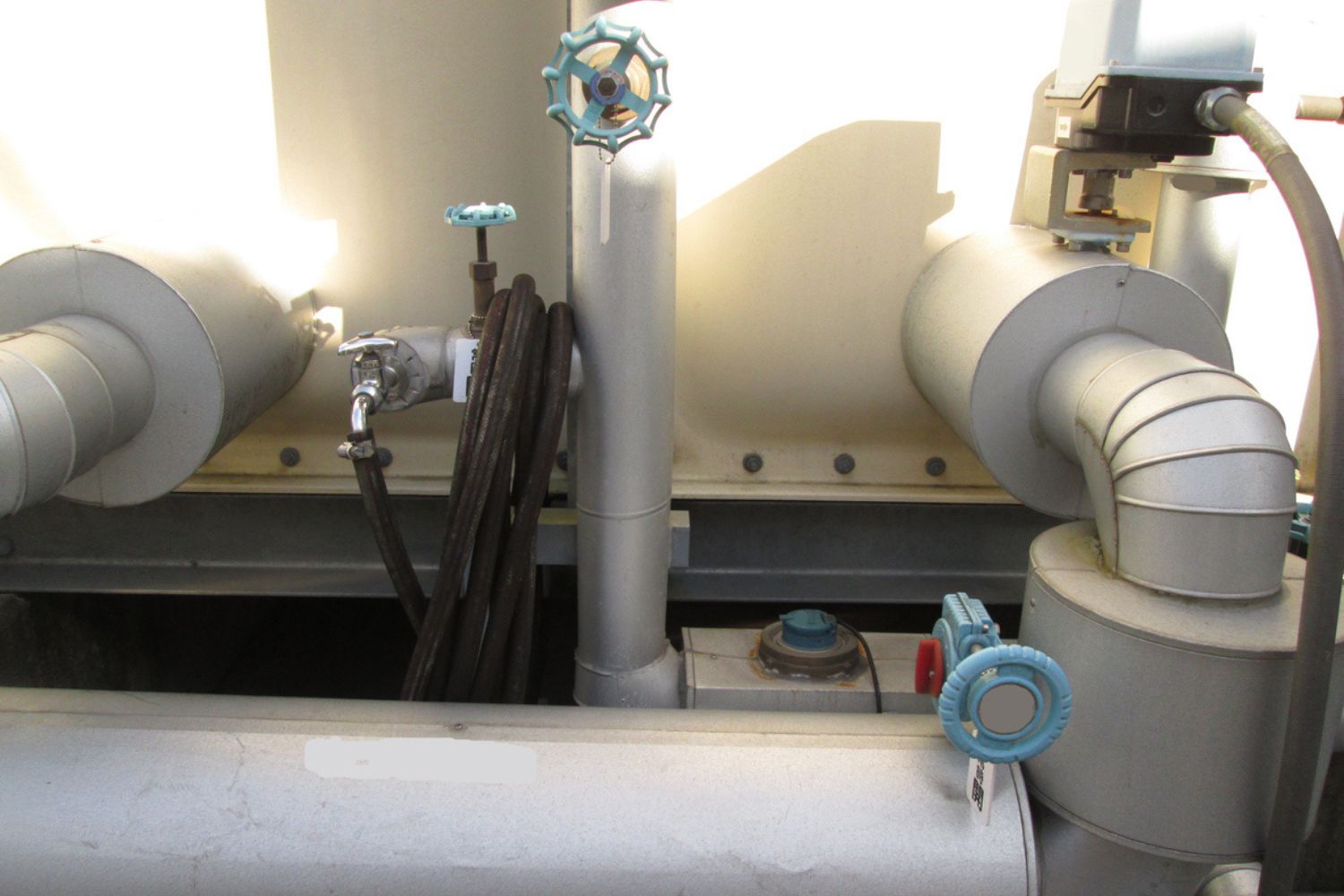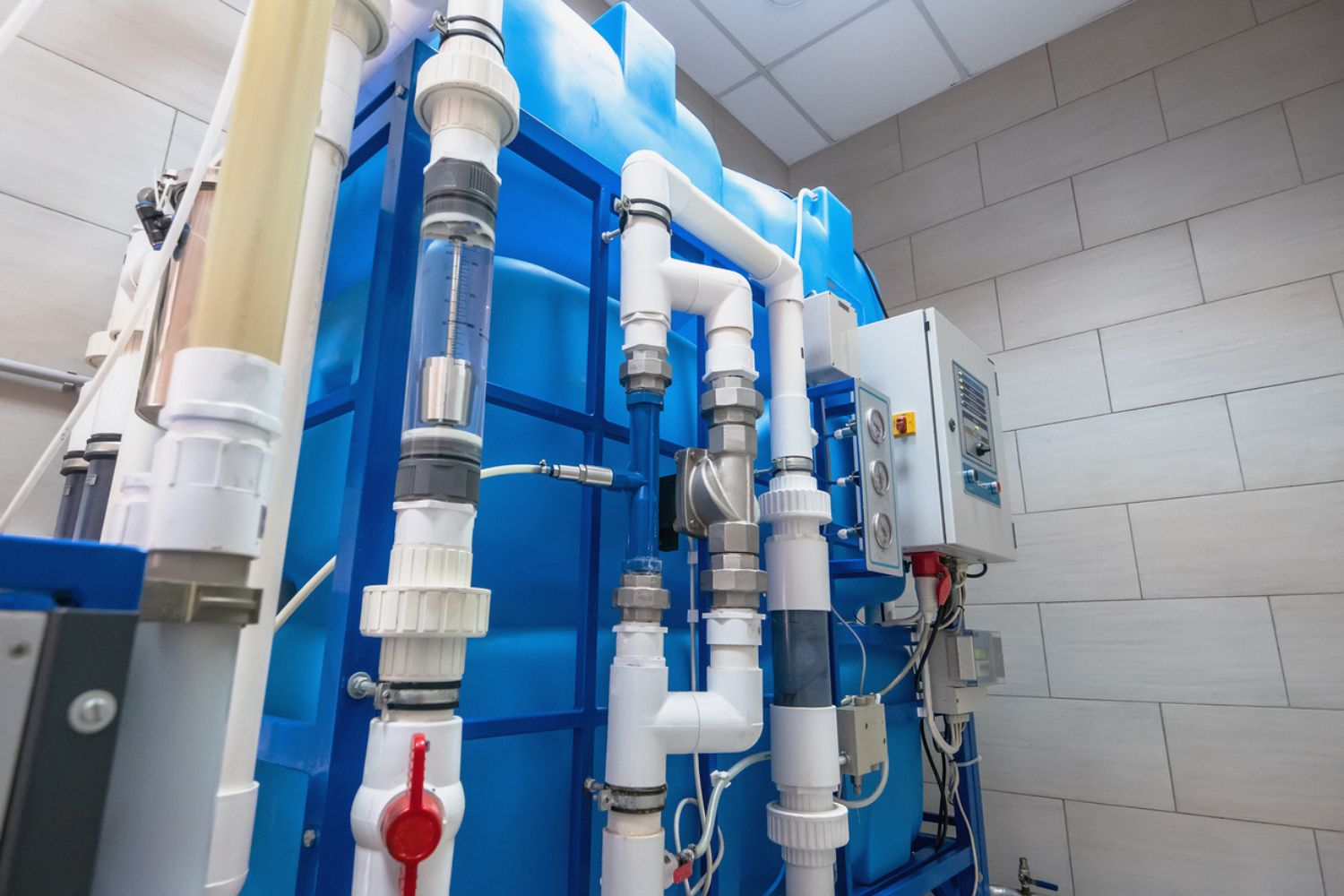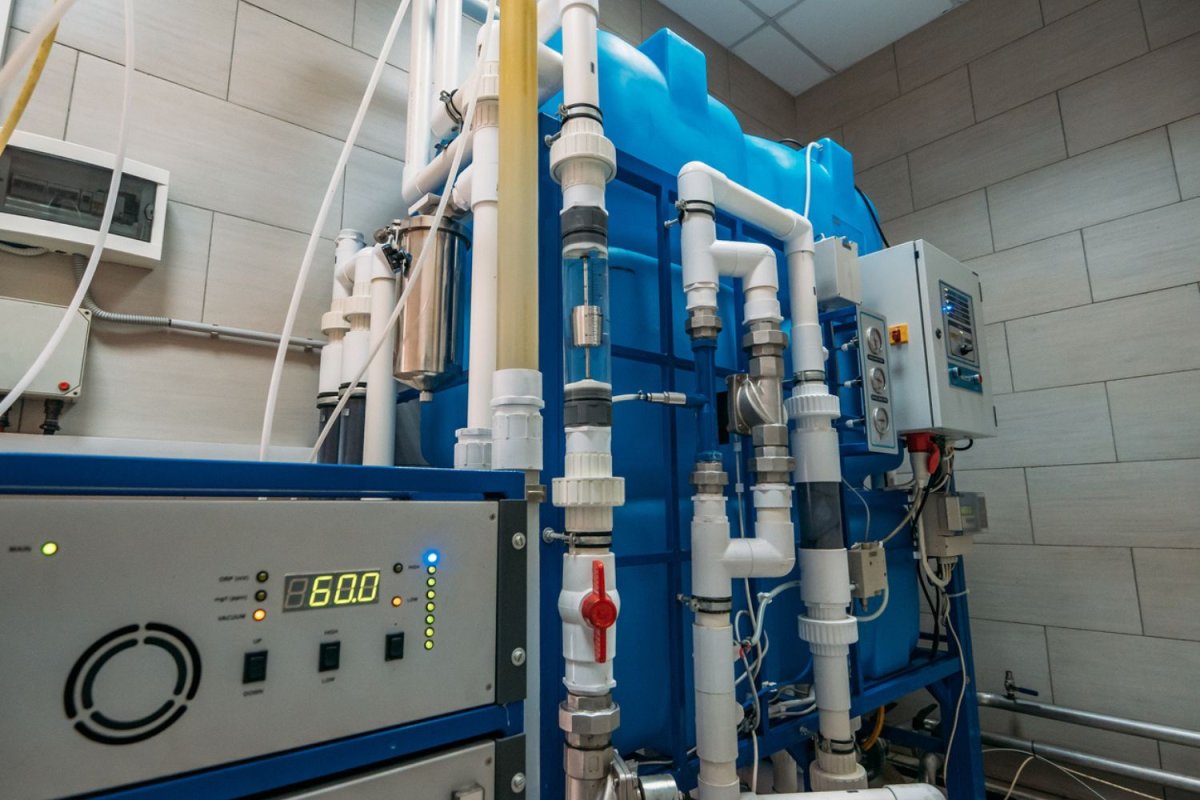We may earn revenue from the products available on this page and participate in affiliate programs. Learn More ›
Highlights
- The average cost of a whole-house reverse osmosis system is $2,200, but a typical range is $150 to $4,800.
- Several factors affect reverse osmosis system cost, including the system’s efficiency, the size and type of system installed, the brand, the filtration process and number of stages, and local labor rates.
- Homeowners who install a whole-house reverse osmosis system enjoy fewer contaminants in their potable water (safe to drink) and improved water taste. It’s also more environmentally friendly to filter tap water than to frequently purchase plastic water bottles.
- Many small reverse osmosis systems can be installed at a single location, such as under a sink, but installing a whole-house reverse osmosis system on the main water line is a project best done by a professional plumber who offers a warranty on the installation.
The quality and composition of municipal water piped into a home can affect the health of the home’s occupants, whether it’s in the form of skin conditions, digestive problems, or other health issues. Municipalities must have their own water treatment facilities to ensure the potable water meets minimum federal standards. Ultimately, the purity of the water entering a house depends on the location of the home, the filtration capabilities of the treatment facility, and the age of the local plumbing infrastructure.
Many homeowners choose to filter their water to ensure contaminants and toxins are removed to a higher degree. With this in mind, a water filtering system for the home, such as a whole-house reverse osmosis system (RO system), is an effective option for filtering out impurities and removing common contaminants regularly found in municipal water, such as arsenic, lead, mercury, chromium-6, chlorine, and mineral sediments. Homeowners will pay about $2,200 on average, though the whole-house reverse osmosis system cost may range from $150 to $4,800, according to HomeAdvisor.

Factors in Calculating Whole-House Reverse Osmosis System Cost
Investing in a water filtering system for home use is a good idea for homeowners who want to improve the purity of the water they use for bathing, cleaning, and drinking. The whole-house water filter cost can vary depending on a variety of factors, including the system efficiency, type, size, and brand. The cost may also fluctuate based on the number of filtration stages in the unit, the filtration process, and local labor rates.
System Efficiency
Typically, a reverse osmosis filter will use about 4 gallons of water for every 1 gallon of water that is purified. This results in about 4 gallons of wastewater that is discharged from the system and returned down the drain like regular wastewater from the home. The best reverse osmosis systems include higher-efficiency processes that reduce the waste produced by the reverse osmosis filter. Newer models can achieve an equal ratio of wastewater and filtered water.
In the long term, excessive wastewater can increase the cost of the water usage bill, so it’s beneficial to invest in a high-efficiency system. Homeowners could pay up to $300 extra for a more efficient RO system. Depending on the amount of water used by a home’s occupants, this additional cost may or may not be worth it.
System Size and Type
The system size and types of water filters are key factors for homeowners to consider when planning a budget for this home upgrade. Generally, a home will use a whole-house reverse osmosis system to treat all incoming water at the point of entry, but some homeowners may choose to use a small point-of-use system that treats water at a single faucet or plumbing fixture. Commercial properties often opt for larger reverse osmosis systems to purify water.
- Point-of-entry reverse osmosis systems are also known as whole-house water filtration systems since they are installed where the water enters the home, allowing the filtration system to treat all incoming water. These systems cost about $1,000 to $4,800, but they may require a water softener add-on for treating very hard water. If including the water softener system cost, then point-of-entry reverse osmosis systems can be as costly as $10,000.
- Point-of-use reverse osmosis systems can be installed under sinks, behind refrigerators, near washing machines, or even on shower pipes to provide filtration to a single faucet or any water-using appliance. These smaller systems cost just $150 to $1,300 to purchase and install.
- Commercial reverse osmosis systems are among the best water filters for restaurants, hotels, distilleries, breweries, and other commercial businesses that prefer to offer better-quality and better-tasting water to their customers. A commercial reverse osmosis system costs between $4,000 to $25,000 to purchase, with installation adding another $500 to $2,000.
System Brand
As with most products, the brand will influence the quality and the cost of the whole-house reverse osmosis system. Premium brands, like Culligan, may cost more but often have higher-quality products, reliable warranties, and readily available replacement parts for repair and maintenance. Some brands may offer a wide variety of products, including commercial, point-of-entry, and point-of-use water filtration systems.
Given the variance in home water filtration system cost, it’s recommended that homeowners research popular brands to determine which product and price is most suitable for the home and the budget.
| Brand | Average Cost (Materials Only) |
| Aquasana | $200 to $250 |
| Brondell | $250 to $450 |
| Culligan | $250 to $2,000 |
| EcoPure | $150 to $250 |
| EcoWater Systems | $300 to $900 |
| Express Water | $150 to $300 |
| GE Pro Elite Water Systems | $200 to $500 |
| Home Master | $200 to $600 |
| iSpring | $200 to $600 |
| Whirlpool | $150 to $200 |
Filtration Process
The whole-house reverse osmosis system cost can be affected by the quality of the filtration process. While all reverse osmosis systems rely on a semipermeable membrane to filter out microscopic contaminants, these membranes range in quality. Low-quality membranes may allow more contaminants to seep through, while high-quality membranes filter out much more contaminants and impurities.
There are regulation differences between well water versus city water, yet all water is prone to contamination to some degree. This is especially true if a main water pipe happens to break during nearby construction or due to age. Regardless of the type of water supply, it’s always a good idea to install a high-quality filter to treat incoming water as it enters the home. This can help prevent health issues caused by contaminated water. By speaking with a representative of a water purification company, homeowners can learn about the common contaminants in their local water and determine which reverse osmosis systems can filter out the pollutants that are most concerning.
Number of Filtration Stages
Depending on the product, RO systems may have between four and seven filtration stages. Generally, the more stages the filtration system has, the higher the cost of the product. The first four stages are known as prefiltration, reverse osmosis, storage, and discharge.
During the prefiltration stage, a whole-house reverse osmosis system allows the water to flow through a particle filter and an activated carbon filter to remove or trap impurities like salt, sand, sediment, chlorine, mercury, copper, and pesticides.
In the reverse osmosis stage, the water is then forced through a semipermeable membrane to filter out the smallest contaminants. Next, in the storage stage, purified water collects in a storage tank for later use. The discharge stage occurs at the same time as the storage stage since the contaminants are pulled from the system and down the drain as wastewater.
Some of the best whole-house water filters offer additional filtration stages that may include a post-treatment carbon filter, UV sterilization feature, and remineralization filter. The second carbon filter removes any odd tastes or odors, while the UV sterilizer kills bacteria, viruses, and other microorganisms. The final stage is the remineralization filter, which adds beneficial minerals back into the water.
Labor
The bulk of a whole-house reverse osmosis system cost can be attributed to the product and installation materials. It’s still important for homeowners to consider the labor rate for the installer, which can vary depending on the installation company, the difficulty of the job, and the demand for this service in the given geographic location.
Typically, the cost of labor for a whole-house reverse osmosis system installation ranges from about $300 to $700. If the job is overly complicated or there are accessibility issues that make it harder to install the filtration system, then the cost may increase to as much as $1,500 for labor. However, the labor cost drops significantly for smaller point-of-use systems, averaging just $150 to $300 for an installation.

Additional Costs and Considerations
After considering the up-front costs for a whole-house reverse osmosis filtration system, it’s necessary for homeowners to decide whether any add-ons or extra features would be beneficial. Additionally, the homeowner will want to consider an ongoing maintenance and operating budget that will cover the cost of repairs, replacement filters, replacement membranes, electricity, and water usage.
Add-Ons and Additional Features
Reverse osmosis water filters are highly beneficial for improving the water quality of a home, yet despite the already impressive filtration capabilities, these systems can be upgraded with add-ons or extra features. One common feature is a water pump to boost the pressure and flow rate, further increasing the efficiency of the system. Water pumps are especially popular for homes with low water pressure.
Another popular add-on is a remineralization filter, which is designed to add beneficial minerals back into the water. However, if the homes in the area have very hard water, then it may be worth it to pay about $800 to $2,500 to cover the cost of a water softener that can treat the hard water problem.
Maintenance Costs
Maintaining an RO system isn’t overly difficult or costly, but if the homeowner doesn’t keep up with maintenance, then the efficiency and reliability of the water filtration system is reduced. Throughout the year, homeowners can regularly perform a visual inspection for any leaks, significant wear, or other damages. They can also use smell and taste to help determine if the system is filtering the water properly.
Reverse osmosis system repairs range from about $150 to $800 depending on the extent of the damage. Additionally, the homeowner will need to replace the filters and the reverse osmosis membrane about once every 3 to 5 years to ensure the unit is filtering at maximum capacity. Filters cost about $20 to $100, while reverse osmosis membranes cost about $50 to $100 each.
Running Costs
The water filtration system works by using water pressure, so in most cases, the homeowner doesn’t need to worry about electricity costs to pump the water. However, if the reverse osmosis system has a booster pump, then it will need to use electricity to operate the pump, thereby increasing the running costs of the unit.
Many whole-house reverse osmosis systems use about 4 gallons of water for every gallon that is purified, though some use as little as 1 gallon for each filtered gallon. Although this wastewater is discharged from the system, it still counts toward the total water usage for the home. On average, the water filtration system will cost about $25 per month per person when used primarily for drinking water, and about $400 per year in water usage and replacement filters.
Types of Whole-House Reverse Osmosis Systems
Not all homeowners want a whole-house reverse osmosis system, so it’s a good idea to consider the various types of reverse osmosis water filters before deciding on the best type for the home. Reverse osmosis water filter types include commercial, point-of-entry, and point-of-use systems, with each having notable benefits and drawbacks.
| Type of Reverse Osmosis System | Average Cost (Materials Only) |
| Commercial | $4,000 to $25,000 |
| Point-of-entry | $1,000 to $4,800 |
| Point-of-use | $150 to $1,300 |
Commercial
Most homes will not require a commercial reverse osmosis system. These systems are designed for businesses and industries that use a substantial amount of purified water. A commercial RO system is significantly larger than a whole-house system, allowing a high volume of water to be filtered for multiple points of use or to fill a large storage tank.
The primary drawback to a commercial reverse osmosis system is that it is simply too large to be considered economical for the majority of personal residences. Additionally, this type of water filtration system comes at a high cost, ranging in price from $4,000 to $25,000 before installation.
Point-of-Entry
The most common option for a whole-house RO system is a point-of-entry model. This type of filter is often called a whole-house reverse osmosis system since it’s designed to filter all incoming water before the water flows to the rest of the home. Since the filtration system is large enough to filter all incoming water, the unit is installed at the point where the incoming water line enters the home.
On average, a point-of-entry (or whole-house reverse osmosis water filtration system) will cost between $1,000 to $4,800. It should be mentioned that the cost to install the filtration system can increase to as much as $10,000 if a water softener package is added for a home that has very hard water.
Point-of-Use
For homeowners looking for one of the best under-sink water filters, a point-of-use reverse osmosis system is a great option. This type of reverse osmosis water filter is intended for installation at a single place such as a sink, shower, refrigerator, or washing machine.
A single point-of-use reverse osmosis filter is not designed to filter the water for an entire home, which is why it’s commonly used in smaller houses and apartments to purify the water at a single tap or fixture. Multiple units can be installed in the home as needed, though. Homeowners can expect to spend between $150 and $1,300 to purchase and install a point-of-use reverse osmosis system for the home.

Benefits of Installing a Whole-House Reverse Osmosis System
Common benefits of reverse osmosis systems include improved water taste, reduced contaminants, and a certain degree of eco-friendliness when compared with using plastic bottles for drinking water.
Reduced Water Contaminants
The primary reason for investing in a whole-house reverse osmosis system is to reduce the amount of contaminants and impurities in the water. Homeowners can research their local contaminant levels through tap water databases such as the Environmental Working Group (EWG) to determine what kind of filtration levels may be needed. Common contaminants include arsenic, lead, mercury, chromium-6, chlorine, and mineral sediments, though these filtration systems are also capable of filtering out pesticides, fluoride, nitrates, sulfates, and more.
If the reverse osmosis system is set up with a UV sterilizer, the water filter can even kill bacteria, fungi, and viruses that would otherwise pass through the reverse osmosis membrane. Homeowners can also add a water softener to the filtration system to help treat hard water and reduce mineral buildup that can damage the home’s plumbing.
Improved Water Taste
Another benefit of having a point-of-entry or whole-house reverse osmosis system is the drastic improvement to the taste of the water. Contaminated or mineral-heavy water doesn’t have the same appealing taste as clean drinking water that has been purified with a reverse osmosis filter. However, since the water filter stores the filtered water in a storage tank until it is needed, the taste and smell can be affected by the storage tank.
To prevent any bad taste or unappealing odors, a whole-house reverse osmosis system with a post-treatment carbon filter can remove any remaining unpleasant tastes and odors before the water flows to the various taps, faucets, and water-using appliances throughout the home.
Eco-Friendliness
Using a whole-house reverse osmosis filtration system is safer and more environmentally friendly than purchasing disposable water bottles. Instead of adding to the demand for more plastic bottles, homeowners can rely on the filtration capabilities of the reverse osmosis system to purify incoming water, leading to a reduction in household waste.
Additionally, studies have shown that many plastic water bottles are filled with common tap water, which means the water isn’t as filtered or purified as it’s often claimed to be. For homeowners who are most concerned about filtering pollutants from their water, using an RO system is the better choice.
Whole-House Reverse Osmosis System Installation: DIY vs. Hiring a Professional
When it comes to deciding between a DIY installation and hiring a professional to install the whole-house reverse osmosis system, there are a few things to consider. The first is the level of skill and expertise of the DIYer. While some DIYers with plumbing experience may be able to install and set up a point-of-use reverse osmosis system at their kitchen sink, this may not be the case for a whole-house reverse osmosis system, which is notably larger and more complex.
Professional plumbers will have both the experience and the proper tools to handle a whole-house reverse osmosis system installation, including the skill to move and replumb any water lines as needed. On average, it will cost about $45 to $200 per hour to hire a plumber, but this fee is well worth the investment for a professionally installed system that is leak-free and covered under the installer’s work warranty. Similarly, a plumber can install a water softener at the same time, if necessary, to further enhance the filtration capabilities of the reverse osmosis water filter.
How to Save Money on Whole-House Reverse Osmosis System Cost
A small point-of-use reverse osmosis filtration system is relatively inexpensive, but a whole-house reverse osmosis system can cost as much as $10,000 in some cases. However, there are ways to reduce the overall whole-house reverse osmosis system costs or save money on maintenance and operating costs.
- Research brands and models for the best price. Not all brands and products are priced the same. Homeowners are encouraged to take some time to research brands and products to find a suitable price for the budget.
- Get quotes from multiple installation companies. Homeowners can obtain quotes from at least three reputable companies in the area to ensure a fair price for the work.
- Consider a refurbished reverse osmosis system. Purchasing a refurbished water filtration system can help reduce the initial cost of the product, but homeowners are advised to check that the refurbished system is covered under a product warranty.
- Select an energy-efficient product. While most reverse osmosis water systems will use about 4 gallons of water for every gallon that is purified, high-efficiency systems can reduce the amount of wastewater, leading to long-term energy and cost savings.
- DIY a point-of-use installation. Depending on the skill of the DIYer, it may be possible to install a point-of-use reverse osmosis system without professional help, though this isn’t an option for all homeowners.
Additionally, purchasing add-on coverage from one of the best home warranty companies, such as Liberty Home Guard, is another effective way to help cover any repairs or possible system upgrades for a whole-house RO system.
Questions to Ask About Whole-House Reverse Osmosis System Installation
Maintaining a whole-house reverse osmosis system is necessary to keep it in good condition for years to come, but it’s also important for maintaining the current efficiency level of the water filtration system. With this goal in mind, it’s recommended that homeowners learn as much as possible about the filters, reverse osmosis membranes, and the type of filtration system. Homeowners can ask several questions to discover more about whole-home reverse osmosis filters and to ensure the job is carried out by qualified professionals.
- Are you licensed, bonded, and insured?
- How long have you installed reverse osmosis systems?
- Do you have references available?
- Do you give free on-site estimates?
- Will the estimated cost of the job change at all?
- What type of system and filters do you recommend for my area?
- Does this system come with a manufacturer’s warranty?
- Will you offer a labor warranty or guarantee on the work?
- Do you test the water first to check if I need a pretreatment filter?
- How do you know which water-filtration system is best for my water supply?
- Is UV treatment recommended?
- Will my system need a water softener attachment?
- How many filters will my RO system have?
- Can you install a reverse osmosis system I bought elsewhere?
- Does the filtration system need a booster pump?
- What is the timeline for project completion?
- How much do filters cost for this system?
- When should the filter be replaced?
- How much does the reverse osmosis system cost to maintain?
- Do you offer a maintenance package?
- How often should I change my RO membrane?
FAQs
Before deciding if the reverse osmosis system cost is worth it for clean, ultra-filtered water right from the tap, homeowners may want to learn more about how long a reverse osmosis water filter system will last, how the system works, and if there are any possible drawbacks to this upgrade. The answers to commonly asked questions about installing and using a reverse osmosis system for the whole house can provide additional insights.
Q. Does a home reverse osmosis system waste water?
Many whole-house reverse osmosis systems use about 4 gallons of water for every 1 gallon that is purified. Newer systems can filter 1 gallon of water and discharge 1 gallon of so-called wastewater. However, this water isn’t wasted; it’s used to clean the filter. The excess wastewater is then discharged from the system and back into the drain like any other used water in the house.
Q. How long does a whole-house RO system last?
A whole-house reverse osmosis water system will require a new reverse osmosis membrane about once every 3 to 5 years, depending on the frequency of use, incoming water purity levels, and system maintenance. If the system has an attached water softener, then it’s worth finding out how long water softeners last so the homeowner can be ready to upgrade the softener when necessary.
Q. What are the disadvantages of installing a reverse osmosis system?
There are several disadvantages for homeowners to consider before investing in a whole-house reverse osmosis system. This type of home water filtering system requires regular filter replacement and can produce excess wastewater and increase water usage costs. Additionally, a reverse osmosis whole-house system has a higher up-front cost than a smaller unit that can be installed at a single point of use, such as a sink or refrigerator.
In areas with very hard water, a reverse osmosis home system may also require a water softener attachment to properly treat the water, which ends up removing all minerals from the water, even the beneficial ones.
Sources: HomeAdvisor, HomeGuide, Forbes, American Home Water


